The old Danish classic dish, rullesteg (Danish rolled pork roast), is something special. Tender meat, filled with prunes, apples, and thyme, is simply delicious! The sauce is a chapter of its own, and when served with potatoes, pickled cucumbers, and a bit of lingonberry jam, it becomes a royal meal in my eyes! Read on and get our recipe for making a homemade rolled pork roast.
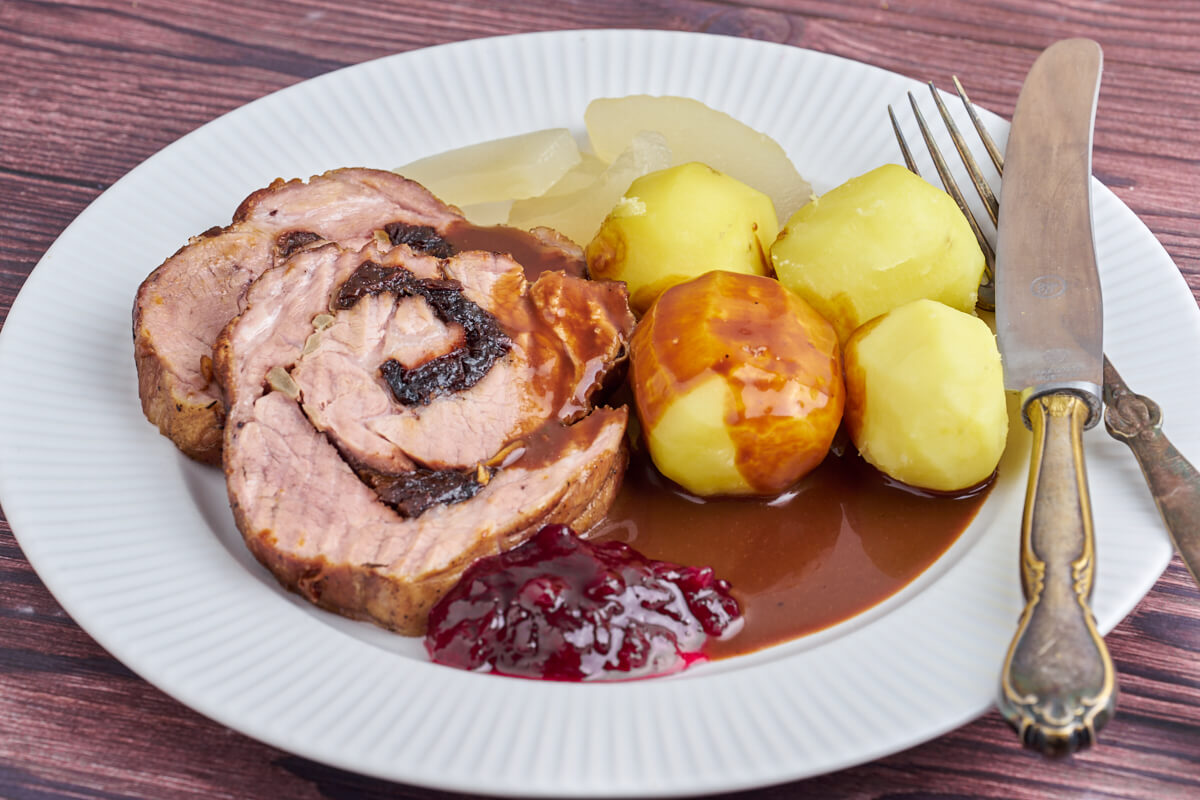
Homemade from scratch
It has been on the calendar for a long time, the homemade rullesteg with all the classic sides. I’ve always managed to avoid it, mainly because I thought it would take a long time to make, but it really didn’t, and the result was definitely worth the effort.
Of course, there’s some work involved in making the dish completely from scratch, especially when it comes to tying the roast. But once you’ve tried tying a roast a few times, it’s not as bad as it seems. I tie it the same way I would tie a rullepølse, and there are plenty of videos online that demonstrate the technique.
In this recipe, I’ve used a neck fillet, which is also called pork collar, as the base for the roast. I think the neck fillet has a good flavor and fat distribution in the meat, and it’s also a relatively inexpensive cut. Normally, a rolled pork roast is made from the same cut used for rullepølse, but personally, I think the neck fillet results in a better roast in the end.
The filling is a matter of personal preference. Prunes are a must, but apart from that, I’ve chosen to add apple and dried thyme to give the roast more flavor, and it works really well in the final result. There is, of course, some work involved in slicing the neck fillet, but it’s not too difficult. Start by making a cut on one side of the meat and continue slicing while rolling out the roast slowly. You should end up with a flat piece of meat about 2 cm thick.
Next, fill it with prunes, apple, thyme, salt, and pepper, and roll the meat tightly again. Now comes the tying part, and it requires a little practice. I use the same method as when making rullepølse—it’s easy, and once you’ve tried it a few times, it becomes second nature.
You can practice tying in advance. I’ve practiced on a whole baguette just to become familiar with the technique. Once the neck fillet is tied up, it’s ready to be browned and put in the pot.
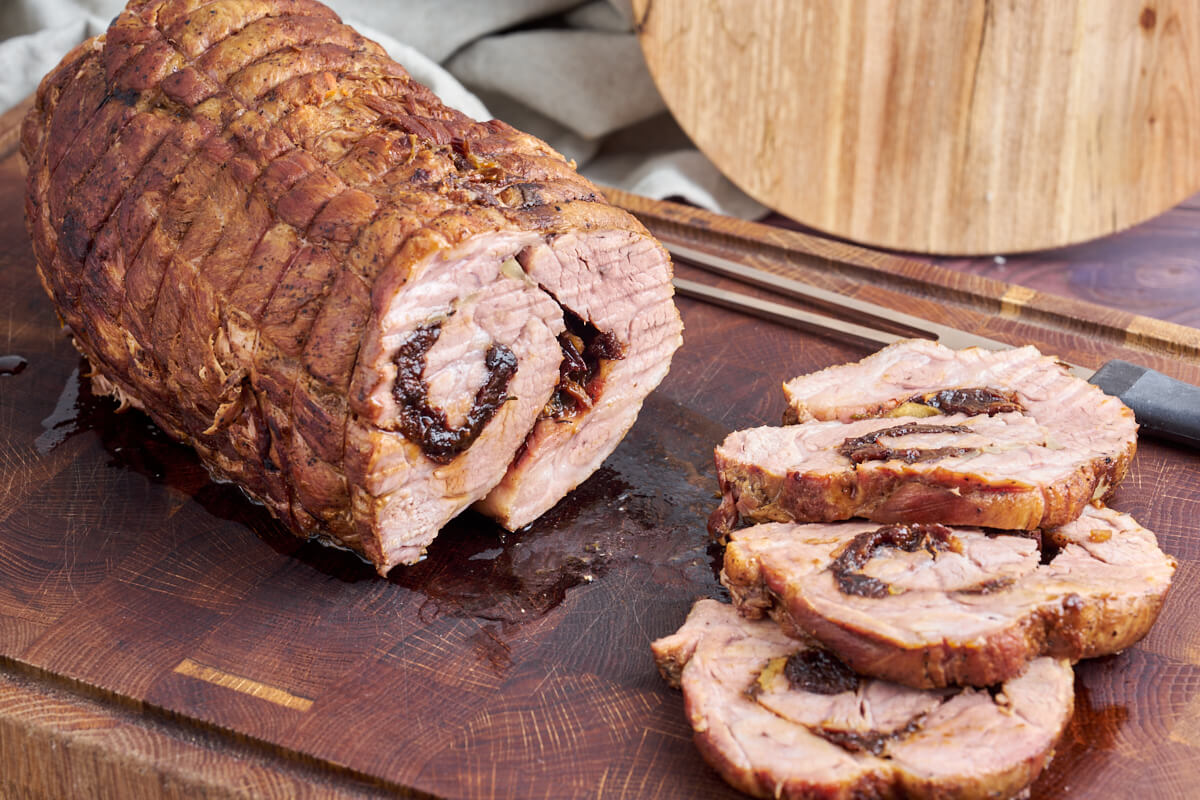
Ingredient notes
Pork collar / Pork Neck fillet – You need to find a large, good neck fillet. The one I used in this recipe weighed 2.3 kg. It’s enough food for many people or several days.
Prunes – Prunes are closely associated with Danish rullesteg. They contribute a delicious sweetness to the roast and the sauce.
Apple – I just used a regular apple, finely chopped. Apple and pork go well together.
Thyme – In the recipe, I chose to use dried thyme. Thyme is a fantastic and flavorful herb that goes really well with pork.
How to make Danish rolled pork roast?
Here’s a “short” description of how to make the best rullesteg from scratch using a neck fillet. You can make the roast the day before and let it sit in the refrigerator until it’s time to brown it. You can also make it and then freeze it, so you have a delicious roast in the freezer for a rainy day.
The already prepared and tied roast is browned on all sides in a pot over high heat. Once it’s well browned, add carrots, onions, parsley, rosemary, water, and pork stock to the pot. Bring it to a boil, cover the pot, and reduce the heat to a simmer.
Now the roast needs to simmer in the broth for about 2.5 hours or until it reaches the desired core temperature. Remember to turn it regularly. When the core temperature is reached, remove the roast from the pot and set it aside to rest uncovered for about 15 minutes. Pour the broth from the pot through a strainer and return it to the pot. Bring the contents of the pot to a boil and finish making the sauce according to the recipe instructions.
Remove and discard the cooking twine from the roast. Slice the roast and serve it with the sauce, boiled potatoes, pickled cucumbers, and lingonberry jam.
Find the full recipe further down this page.
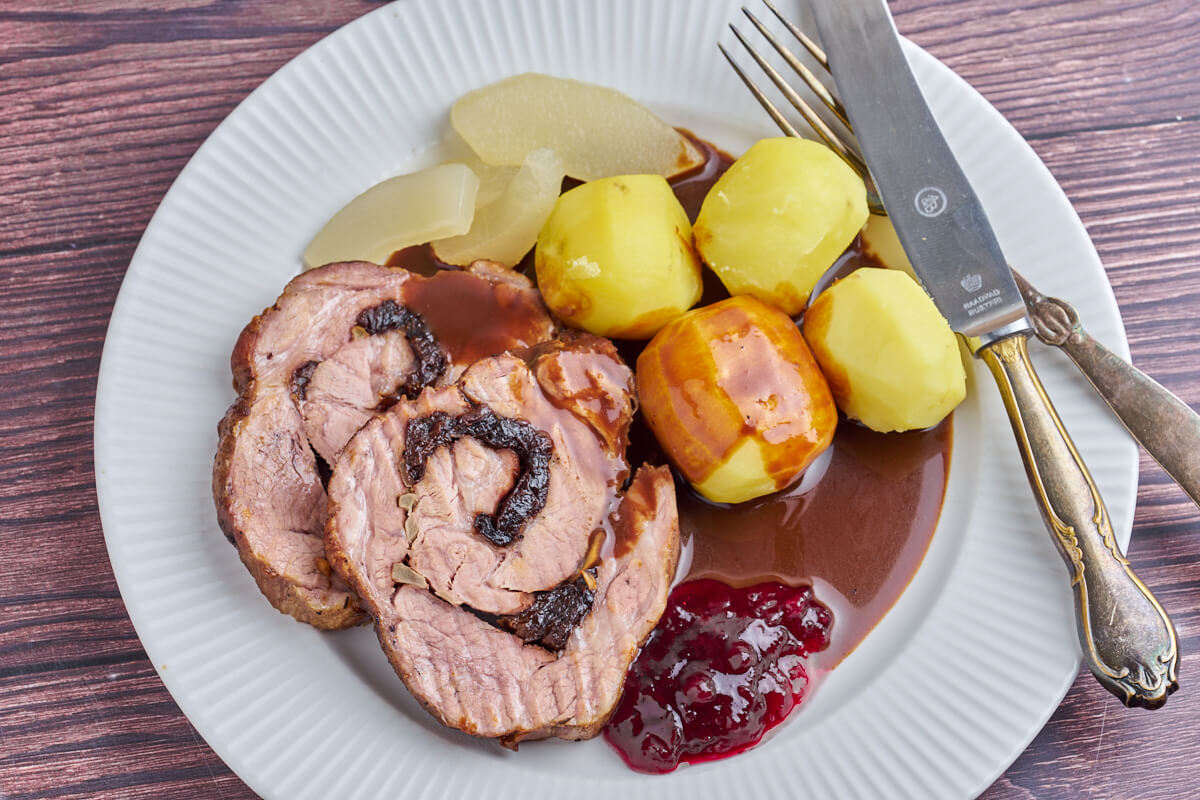
Frequently asked questions
Leftover roast can be kept in the refrigerator for a couple of days or frozen.
Rullesteg can also be made with pork shoulder or another cut.
Other danish dinner recipes you might like
- Danish meatloaf
- Danish breaded pork patties (krebinetter)
- Danish beef patties with caramelized onions
- Danish hash (biksemad)
- Danish burning love (brændende kærlighed)
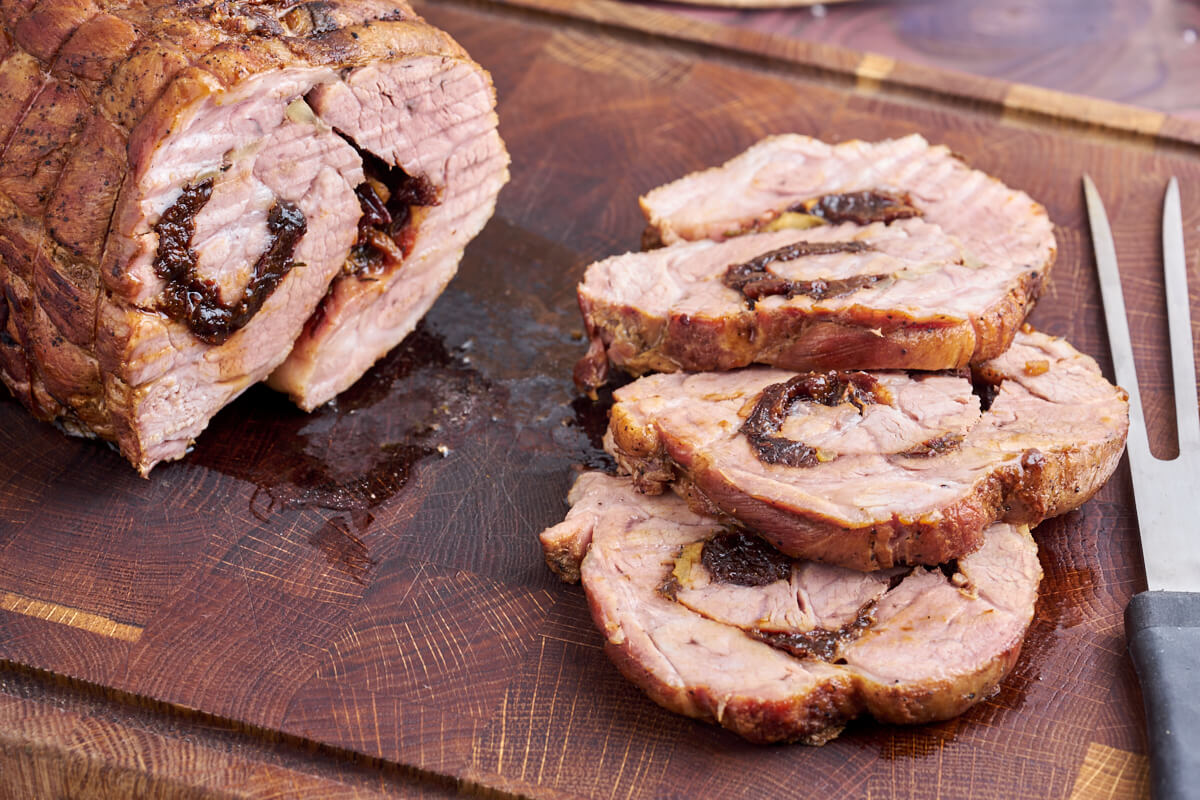
Tips and tricks for the recipe
- Remember to practice tying the roast a few times before handling the real thing.
- Prepare the roast the day before to save time in the kitchen.
- Season the inside of the roast generously with salt and pepper. You can also add fresh parsley.
- Add plenty of herbs to the pot along with the roast; it will make the sauce even better.
- Save the leftovers for sandwiches or the ultimate Danish hash.
Serving suggestions
- Serve homemade rullesteg with sauce, boiled potatoes, pickled cucumbers, and lingonberry jam.
- You can also serve the roast with sauce, boiled potatoes, and delicious homemade red cabbage.
Do you also enjoy classic Danish dishes?
Try our recipe for classic Danish meatballs in curry (boller i karry)
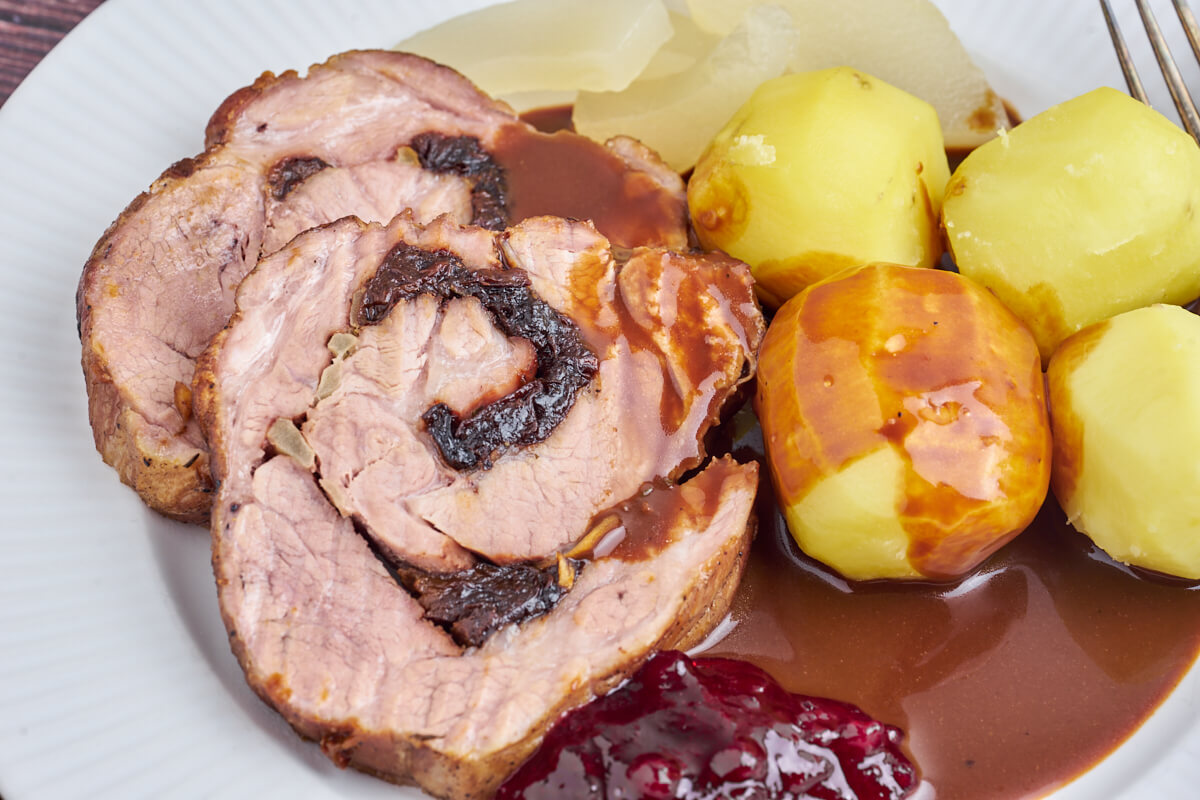
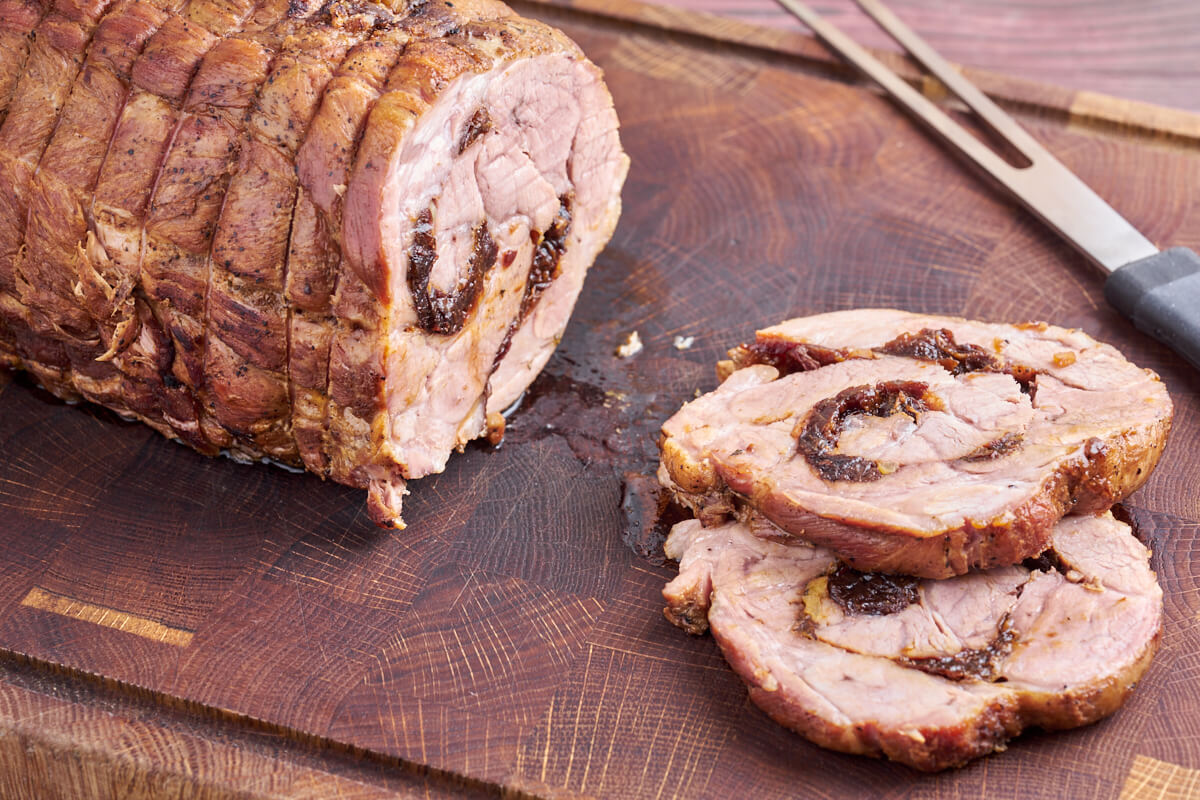
Recipe for the best homemade rullesteg in a pot
Here’s our recipe for Danish rullesteg in a pot made from scratch. It’s perfectly tender and juicy with the right flavor.
Serve it sliced with boiled potatoes, the delicious sauce, some pickled cucumbers, and lingonberry jam or your favorite side dishes. We hope you feel inspired to try the recipe and serve the roast with prunes to your family.
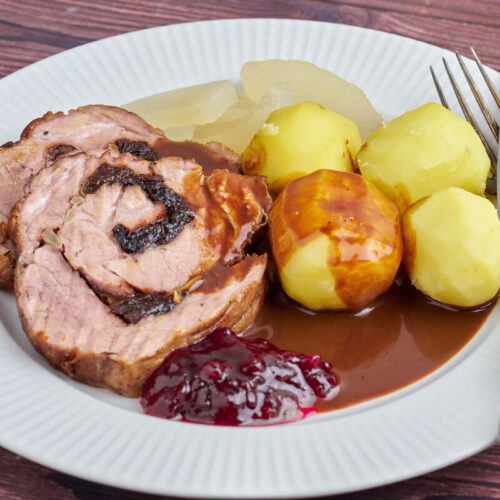
Danish rolled pork roast
Ingredients
Roast
- 2.3 kg Pork neck fillet Pork collar
- 200 g prunes
- 1 apple
- 1.5 tsp salt
- 1.5 tsp dried thyme
- Pepper
- 2 tbsp olive oil
- 2 tbsp butter
For the pot
- 2 carrots
- 2 onions
- Fresh parsley
- Fresh rosemary
- 1.5 liters water
- 1.5 pork stock cubes
Gravy
- 1 tbsp red currant jelly or apple jelly
- 1.5 tbsp gravy browning
- 1 tbsp red wine vinegar
- 1.5 dl heavy cream
- 3 tbsp all-purpose flour
- 1 tsp sugar
- Salt
- Pepper
Instructions
Preparation of the roast
-
Unwrap the neck fillet and trim off excess fat.2.3 kg Pork neck fillet
-
Make a cut on one side and roll the fillet, ending up with a "slab" that is a couple of centimeters thick.
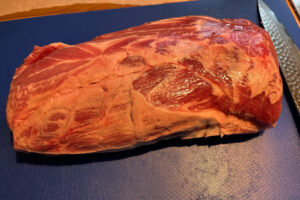
-
Season the slab with salt, pepper, and dried thyme. Finely chop the prunes and apple, after peeling the apple.200 g prunes, 1.5 tsp salt, 1.5 tsp dried thyme, Pepper, 1 apple
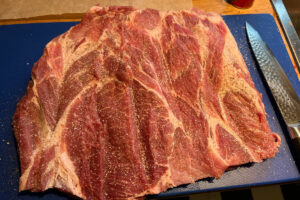
-
Evenly distribute the apple and prunes over the slab. Roll it tightly so that the seam is facing downward.
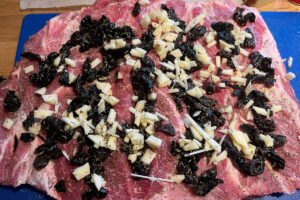
-
Now, the roast needs to be tied just like a sausage. – Start by making a lengthwise tie on the roast. Then, begin from one end and tie at intervals of about 1 centimeter, making sure to tighten them securely. – When you reach the other end of the roast, make a couple of self-tightening ties or knots to prevent it from coming apart during cooking.
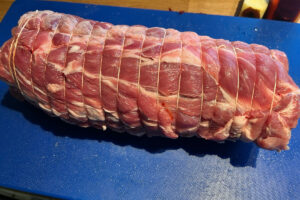
- The roast can now be refrigerated until ready to cook. It can also be frozen for later use.
Cooking the roast
-
Heat olive oil and butter in a pan or a large pot over high heat, and brown the roast on all sides. Once the roast is browned, continue cooking in a pot.2 tbsp olive oil, 2 tbsp butter
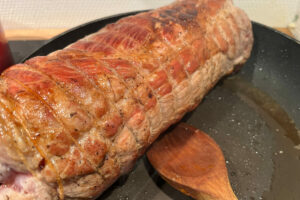
-
Place the roast in a pot. Add carrot slices, halved onions (skin intact), rosemary, parsley, water, and pork stock.2 carrots, 2 onions, Fresh parsley, Fresh rosemary, 1.5 liters water, 1.5 pork stock cubes
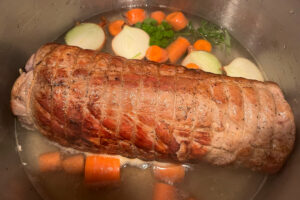
- Cover the pot with a lid. Bring the contents to a boil and then reduce the heat to medium-low, allowing it to simmer. Cook the roast for approximately 2.5 hours or until the internal temperature reaches about 70 degrees Celsius.
- Remember to turn the roast a few times during cooking.
-
Once the cooking time is complete and the internal temperature is reached, remove the roast from the pot and place it on a serving dish or cutting board. Let it rest, uncovered, for about 15 minutes.
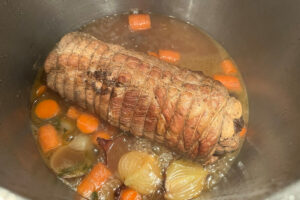
Preparing the gravy
-
Pour the remaining liquid from the pot through a sieve back into the pot. Bring it to a boil and add red currant jelly, gravy browning, and red wine vinegar. Let it simmer for a few minutes.1 tbsp red currant jelly, 1.5 tbsp gravy browning, 1 tbsp red wine vinegar
-
In a separate bowl, whisk the flour into the cream and then add it to the liquid in the pot while continuously whisking to avoid lumps. Add sugar and season the gravy with salt, pepper, and additional red currant jelly to taste.1.5 dl heavy cream, 3 tbsp all-purpose flour, 1 tsp sugar, Salt, Pepper
- If a thicker gravy is desired, it can be further thickened with 2 tablespoons of cornstarch dissolved in 2-3 tablespoons of water. Whisk it into the gravy until the desired consistency is achieved.
Serving
- Slice the roast and serve it with boiled potatoes, gravy, and pickles.
Nutrition
How do you like the recipe?
Have you tried this recipe? We’d love to hear what you think of it. Leave a comment, add a number of stars to the recipe and share your photo on Instagram with #madformadelskere – We love seeing your dishes ♥️
Also, sign up for our Facebook group where you can show pictures of the delicious food you make! You can find the Facebook group here
